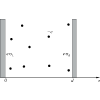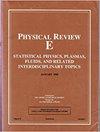Strong-coupling effective-field theory for asymmetrically charged plates with counterions only
IF 2.4
3区 物理与天体物理
Q1 Mathematics
引用次数: 0
Abstract
We are interested in rationalizing the phenomenon of like-charge attraction between charged bodies, such as a pair of colloids, in the strong coupling regime. The two colloids are modelled as uniformly charged parallel plates, neutralized by mobile counterions. In an earlier work [Palaia et al., J. Phys. Chem. B 126, 3143 (2022)], we developed an effective-field theory for symmetric plates, stemming from the ground-state description that holds at infinite couplings. Here, we generalize the approach to the asymmetric case, where the plates bear charges of the same sign, but of different values. In the symmetric situation, the mobile ions, which are localized in the vicinity of the two plates, share equally between both of them. Here, the sharing is nontrivial, depending both on the coupling parameter and the distance between the plates. We thus introduce a counterion occupation parameter that is determined variationally to ensure minimum of the free energy. The analytical results for the pressure as a function of the plate-plate distance agree well with our Monte Carlo data, in a large interval of strong and intermediate coupling constants . We show in particular that within this description there exists a range of large distances at which the attractive pressure features a behavior.

仅带反离子的不对称带电板的强耦合有效场理论
我们有兴趣对带电体(如一对胶体)之间在强耦合机制下的同类电荷吸引力现象进行合理解释。这两个胶体被模拟成均匀带电的平行板,由移动反离子中和。在早先的研究中[Palaia 等人,J. Phys. Chem. B 126, 3143 (2022)],我们从无限耦合条件下的基态描述出发,建立了对称板的有效场理论。在此,我们将这一方法推广到非对称情况,即板上的电荷符号相同,但电荷值不同。在对称情况下,移动离子位于两板附近,在两板之间平均分享。在这种情况下,移动离子在两块板之间的分担是非对等的,取决于耦合参数和两块板之间的距离。因此,我们引入了一个可变的反离子占据参数,以确保自由能最小。在强耦合常数 Ξ 和中间耦合常数 Ξ 的较大范围内,压力随板间距 d 变化的分析结果与蒙特卡罗数据非常吻合。我们特别表明,在这一描述范围内,存在一个大距离范围,在该距离范围内,吸引力压力的特征是 1/d2 行为。
本文章由计算机程序翻译,如有差异,请以英文原文为准。
求助全文
约1分钟内获得全文
求助全文
来源期刊

Physical review. E
物理-物理:流体与等离子体
CiteScore
4.60
自引率
16.70%
发文量
0
审稿时长
3.3 months
期刊介绍:
Physical Review E (PRE), broad and interdisciplinary in scope, focuses on collective phenomena of many-body systems, with statistical physics and nonlinear dynamics as the central themes of the journal. Physical Review E publishes recent developments in biological and soft matter physics including granular materials, colloids, complex fluids, liquid crystals, and polymers. The journal covers fluid dynamics and plasma physics and includes sections on computational and interdisciplinary physics, for example, complex networks.
 求助内容:
求助内容: 应助结果提醒方式:
应助结果提醒方式:


